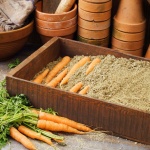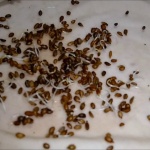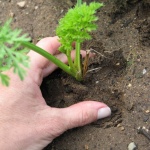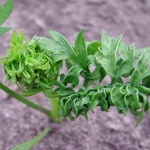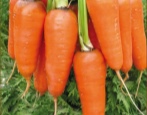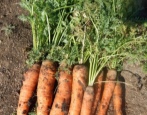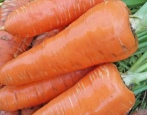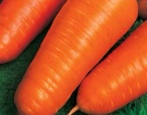
- Authors: Ugarova S.V., Dederko V.N.
- Year of approval: 2009
- Appointment: for fresh consumption, for canning, for freezing, for bundled products, for making juice
- Leaf rosette shape: semi-spreading
- Leaves: medium to long, green to dark green, medium to coarsely dissected
- Weight, g: 85-183
- The form : elongated conical with a slightly pointed tip
- Taste qualities: good and excellent
- Composition : dry matter 12.3-15.7%, total sugar 7.2-8.7%, carotene up to 16.4 mg per 100 g of raw matter
- Ripening terms: mid-season
Solomon is a carrot variety bred by Russian specialists and approved for use in 2009. The hybrid soon became popular for its size and taste. It is grown both in summer cottages and on an industrial scale.
Description of the variety
This is a large variety, the marketability of which is 68-91%. The vegetable easily tolerates long-term storage. It does not lose its marketability and taste even when stored until the end of spring. Also among the advantages are good yield, versatility of use and unpretentiousness to growing conditions. Solomon will feel more comfortable when cultivating in the West Siberian region.
Characteristics of the appearance of the plant and root crops
The rosette is semi-spreading, the leaves are medium or long, the tubers are large, developing in the form of an elongated cone with a pointed tip. The average weight of carrots is 85-183 g, the length is 25-27 cm, the skin and core are orange.
Purpose and taste of tubers
Solomon's pulp is very juicy, sweet in taste, so many consumers recommend eating this carrot exclusively fresh. However, it is perfect for thermal processing, and for freezing, and for canning, and for making juice. In addition, the pulp contains a large amount of useful carotene, some of which is retained even after processing.
Maturation
Harvesting is possible only 120-140 days after the appearance of the first shoots, which is typical for varieties with a mid-ripening period.
Yield
The variety belongs to the productive varieties and brings on average 229-416 quintals of carrots per hectare.
Growing and care
Sowing is carried out in April-May. A later planting can cause a slow development of the culture. When choosing a site, give preference to places where corn, cabbage, beets, tomatoes used to grow. The plant will grow best in light, loose soil, which is important to prepare it in the fall. If the soil is too acidic, then this deficiency is corrected by introducing lime. To make the ridge more comfortable for carrots, sand and humus are added to it. It is also important that the site is in direct sunlight.
Before sowing, the seeds should also be prepared. First, they are treated for 30 minutes in a solution of potassium permanganate, then washed and heated in warm water for 20 minutes. Then they need to be placed in a growth stimulator for a day, and only then proceed to sowing. Disembarkation consists of the following stages:
- prepare grooves at a distance of 18-20 cm, moisturize them well;
- sow the seeds evenly, deepening them by 1-2 cm;
- lightly dig in the seeds with soil and tamp a little;
- Sprinkle over the planting site.
The first thinning will be required a couple of weeks after the seedlings hatch. The second time the sprouts are thinned out after another three weeks. Loosen the soil and remove weeds regularly while grooming. Let us dwell in more detail on several points when growing the Solomon variety.
- Top dressing.
The plant needs fertilization three times a season. Additional nutrition is applied by the root method after moistening.In order for the culture to develop green mass, it is fed with mixtures with a nitrogen content, and at the three-leaf stage, ammonium nitrate or organic matter, for example, bird droppings or slurry, is used. More organic matter is not required, continue to feed the plant with fertilizers that contain potassium and phosphorus - these substances contribute to the growth of the mass of tubers.
- Watering.
These carrots respond well to timely irrigation of the soil, but it is important not to use too much water. During the rainy season, it is advisable to organize the removal of moisture from the garden. Until shoots appear, the soil should always be moistened, and when the tubers reach normal size, watering can be stopped. To keep moisture in the ground longer, the garden bed is mulched.
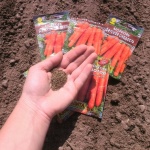
Carrots are one of the most unpretentious crops in terms of growing conditions; they can endure a short drought and a short cold snap. However, to get tasty and large root crops, you should adhere to the basic rules for planting carrots.

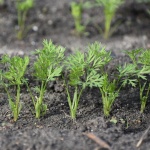
Disease and pest resistance
This variety does not withstand overflows, which means that it can be susceptible to rot, fungus, spotting, and phomosis. To protect the culture, you can use the means "Oxyhom", "Fundazol" or 1% Bordeaux liquid. Affected specimens are removed and destroyed.
Among insects, this vegetable is most loved by carrot flies, flies and scoops. In the event of an attack by these pests, use Actellik. In addition, gardeners also recommend folk remedies, for example, infusions of tobacco and onion peels.
As a preventive measure, observe a competent crop rotation, disinfect the planting material, remove plant debris in a timely manner, keep the site clean, and avoid waterlogging of the soil.

Carrots grow in almost any garden. There is an opinion that this culture is very resistant to all kinds of diseases and pests, but this is not the case. Without proper care, carrots become susceptible to all kinds of infections and are affected by harmful insects.

